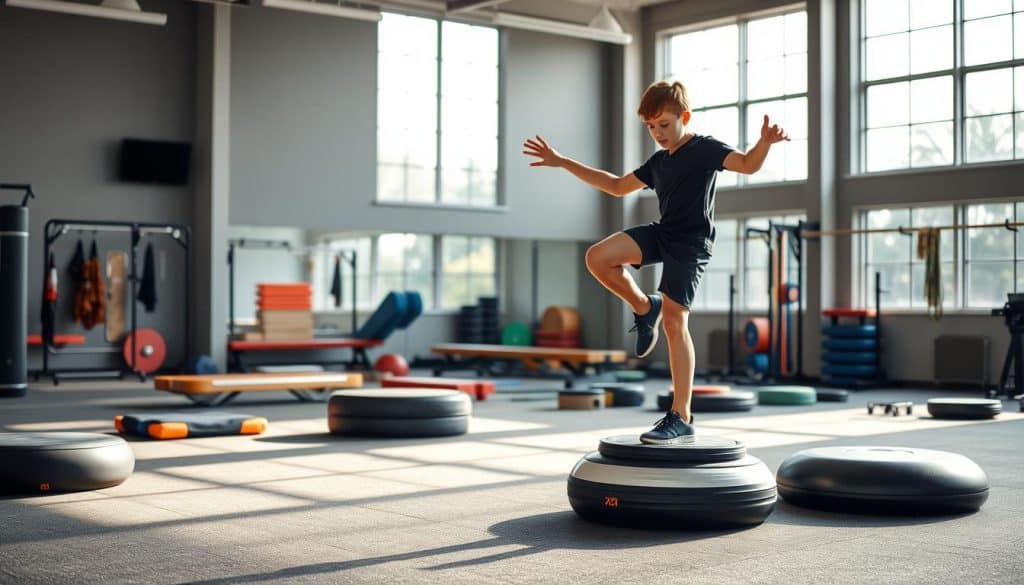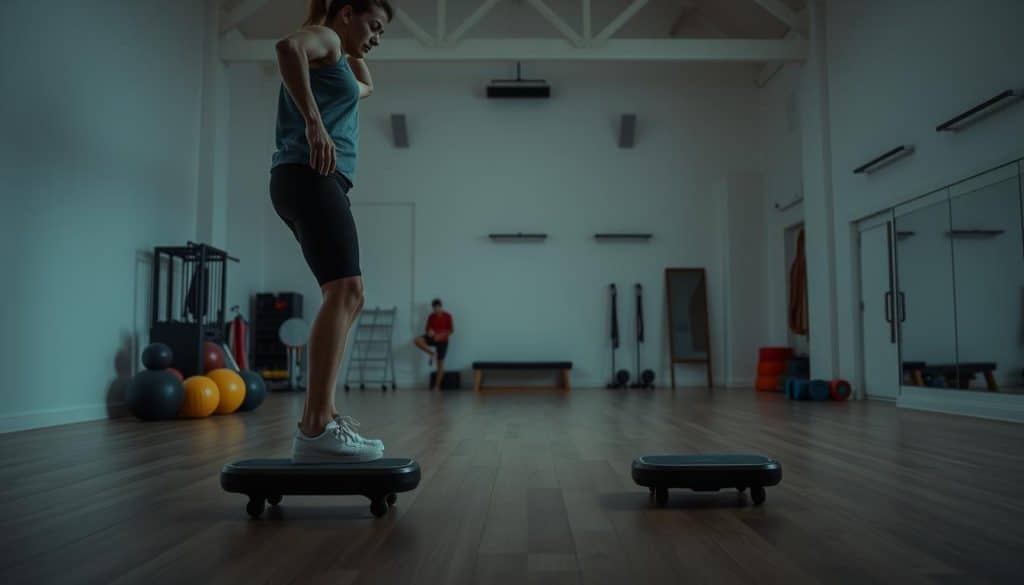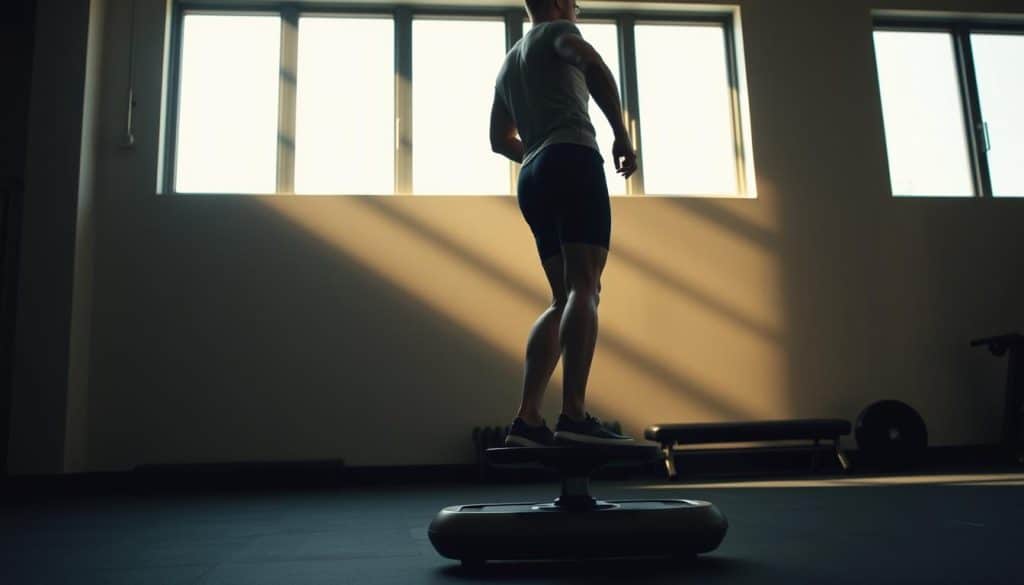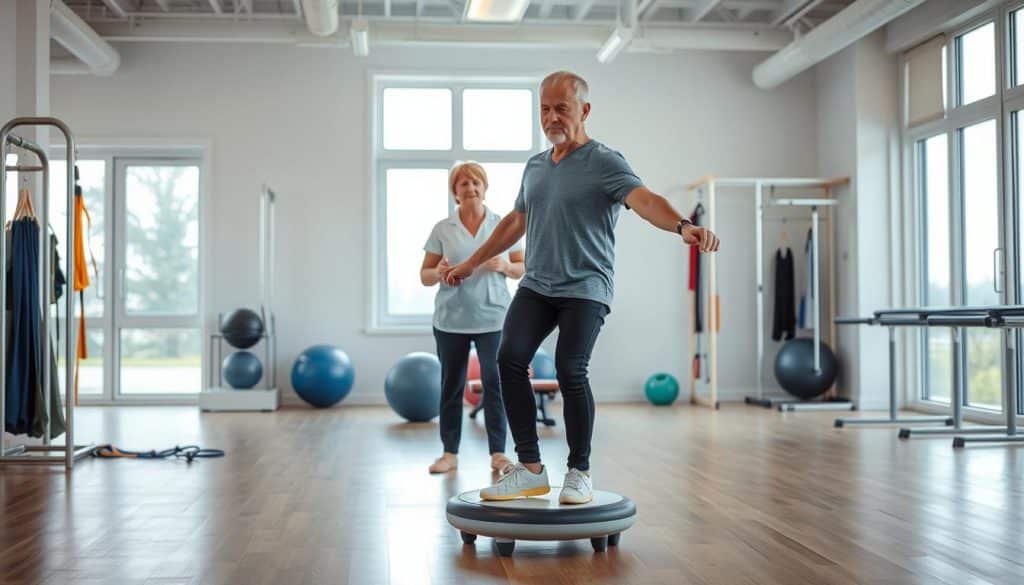Your body’s ability to sense its position in space acts like an internal GPS. This natural skill helps you walk without staring at your feet or catch a ball without calculating angles. At Riverside Sports Therapy in Calgary, we focus on enhancing this hidden sense through specialized methods.
Studies show improved movement coordination reduces injury risks by up to 40% in active individuals. Our team uses evidence-based approaches to help clients regain stability after injuries or boost athletic performance. Whether recovering from a sprain or training for peak results, body awareness plays a vital role.
Research from systematic reviews confirms structured programs significantly improve balance and reaction times. This article explores practical applications for daily life, sports, and recovery processes. You’ll learn how simple exercises can sharpen reflexes and build confidence in motion.
Located in Calgary, AB, Riverside Sports Therapy offers personalized care for all ages and activity levels. Call us at (403)283-7551 to discuss how we can help you move smarter and safer.
Key Takeaways
- Body awareness training enhances natural movement coordination
- Calgary-based programs reduce injury risks through proven methods
- Balance improvement supports both rehabilitation and athletic goals
- Scientific research validates structured intervention benefits
- Personalized therapy adapts to different needs and skill levels
Understanding Proprioception
Hidden sensors in your muscles and joints constantly relay data about your physical stance. This internal guidance system helps you maintain posture, adjust movements, and interact with your environment seamlessly.
How Your Body Maps Movement
Specialized receptors called proprioceptors detect changes in muscle length, joint angles, and tension. These sensors send instant updates through your nervous system to the brain. Together, they create a real-time map of your body’s position without conscious effort.
Sensory Feedback in Action
Your brain processes this stream of information to coordinate even complex motions. For example, when walking on icy sidewalks, your system adjusts foot placement automatically. This feedback loop operates both during deliberate actions and reflexive responses.
Research shows this biological system works best when challenged through varied movements. Simple tasks like standing on one leg or catching a thrown object demonstrate how position awareness supports daily activities. Regular practice strengthens these neural pathways, enhancing overall physical confidence.
The Role of Proprioception in Daily Life
Every action you perform, from tying shoes to climbing stairs, relies on an unseen guidance system. This natural coordination allows you to navigate crowded spaces, carry groceries, or play with children without second-guessing every motion. Our body’s positional intelligence works quietly in the background, making routine activities feel effortless.
Everyday Movements and Balance
Walking across a parking lot or standing in line requires constant adjustments. Your feet sense uneven pavement, while your core stabilizes to prevent wobbling. This automatic response depends on precise movement mapping – your brain’s way of tracking limb positions and surface conditions.
Balance plays a critical role in preventing slips on icy Calgary sidewalks or wet floors. When stepping off a curb, your ankles and knees instantly adapt to height changes. This split-second coordination keeps you upright, even when surfaces shift unexpectedly.
Smooth transitions between tasks – like sitting down or reaching for a coffee cup – demonstrate this system’s efficiency. Research shows people with refined body awareness perform these actions faster and with less strain. Improved function translates to safer home environments and greater confidence during activities like gardening or playing sports.
Regularly challenging your balance strengthens these neural pathways. Simple practices – standing on one leg while brushing teeth or walking heel-to-toe – sharpen reflexes. Over time, this builds resilience against falls and supports independent living at any age.
Proprioception and Athletic Performance
Elite athletes rely on precise body awareness to execute complex maneuvers with split-second timing. This biological feedback system allows quarterbacks to throw accurate passes and gymnasts to stick landings. At Riverside Sports Therapy, we help Calgary athletes refine these skills through targeted programs.

Enhancing Coordination and Agility
Specialized drills improve how athletes process movement signals. A 2023 sports medicine study found participants increased reaction speeds by 18% after 6 weeks of structured practice. These exercises strengthen neural connections between muscles and the brain.
Key benefits include:
- Better weight distribution during rapid direction changes
- Faster recovery from off-balance positions
- Improved force modulation during jumps or throws
Sport-Specific Proprioceptive Demands
Different activities challenge the body in unique ways. Hockey players need ankle stability for sharp turns, while volleyball athletes require shoulder control for powerful spikes. Our therapists design routines addressing these distinct needs.
| Sport | Key Stability Area | Common Exercises |
|---|---|---|
| Basketball | Ankle/Knee Complex | Single-leg catches, wobble board drills |
| Soccer | Hip Alignment | Direction-change sprints, uneven surface dribbling |
| Rock Climbing | Finger/Shoulder Control | Grip-strength challenges, body positioning tasks |
Consistent practice helps maintain peak physical function. Athletes report better movement economy – using less energy for the same performance level. This edge often separates podium finishers from competitors.
proprioception training importance
Body awareness development through specific exercises differs from standard workouts. Structured programs target how your nervous system interprets movement signals. This approach sharpens your ability to sense joint angles and muscle tension during actions.

Clarifying the Concept
Proprioceptive training focuses on improving joint position awareness and movement control. Unlike general fitness routines, these exercises challenge your body’s feedback systems. Therapists might move a patient’s limb passively during rehabilitation, while athletes actively perform drills on unstable surfaces.
Key differences emerge in program design:
| Setting | Exercise Type | Key Benefit |
|---|---|---|
| Clinical | Balance board rehabilitation | Restores ankle stability post-injury |
| Athletic | Single-leg catches on foam pads | Enhances reactive adjustments mid-game |
Effective programs use real-time feedback to refine joint positioning. A 2022 study showed dancers improved balance by 27% using mirror-based corrections. This input helps the brain adjust movements milliseconds faster.
Measurable outcomes include better test scores on balance assessments and lower reinjury rates. Calgary hockey players using these methods report quicker recovery from unexpected collisions. Targeted practice builds smarter movement patterns that last.
Injury Prevention Through Proprioceptive Training
A 2023 sports medicine review revealed athletes using targeted exercises experienced 45% fewer ankle sprains than control groups. These specialized drills strengthen the body’s ability to anticipate and respond to unstable surfaces – a critical skill for preventing injuries during sports or daily activities.

Joint Stability Meets Smart Movement
Proprioceptive exercises teach joints to communicate faster with the brain. When stepping on uneven terrain, trained individuals adjust foot position 0.2 seconds quicker according to gait analysis studies. This rapid response reduces injury risk by preventing awkward twists or falls.
Key mechanisms include:
- Improved muscle activation patterns around vulnerable joints
- Enhanced surface adaptation during weight-bearing tasks
- Better force absorption through proper limb alignment
Evidence-Based Protection Strategies
Research highlights measurable protection across populations:
| Group | Intervention | Risk Reduction |
|---|---|---|
| Soccer Players | 6-week balance program | 38% fewer knee injuries |
| Seniors | Daily stability exercises | 52% lower fall rate |
Calgary therapists combine wobble boards and reaction drills to simulate real-world challenges. One client reduced recurrent ankle sprains from 3 yearly incidents to zero through consistent practice. As neural pathways strengthen, the body becomes adept at avoiding injury-causing positions.
Scientific Evidence Supporting Proprioceptive Training
Modern research validates how targeted movement exercises boost physical performance and safety. A 2024 systematic review analyzing 32 studies found structured programs enhanced joint position accuracy by 41% across age groups. These interventions help the brain process movement information faster, leading to measurable gains in daily and athletic tasks.
Clinical trials demonstrate significant improvements in sensorimotor function. Participants using balance boards for 8 weeks showed:
- 34% better error correction during sudden surface changes
- 28% faster muscle response times
- 19% increase in movement precision tests
Data from rehabilitation centers reveals how specific drills rewire neural pathways. Patients recovering from knee surgery improved their motor control scores by 52% using wobble cushion exercises. These changes help maintain proper limb alignment during complex motions like stair climbing or pivoting.
| Study Focus | Duration | Key Outcome |
|---|---|---|
| Ankle Stability | 6 weeks | 67% fewer missteps on uneven terrain |
| Senior Balance | 12 weeks | 58% reduction in near-fall incidents |
This growing body of evidence confirms that enhancing body awareness through science-backed methods benefits everyone. From weekend warriors to office workers, better movement function translates to safer, more confident physical engagement.
Proprioception and Joint Stability
Stability in movement starts with your body’s silent dialogue between joints and muscles. This partnership allows precise adjustments during activities like climbing stairs or pivoting on icy terrain. Research confirms enhanced sensory feedback reduces reinjury risks by up to 52% in vulnerable areas like knees and ankles.
Focus on Knee and Ankle Health
Specialized receptors in ligaments and tendons act as biological alarms. When knees bend or ankles tilt, these sensors trigger muscle responses to prevent overextension. A 2022 clinical trial showed targeted exercises improved range of motion by 31% in patients with chronic joint instability.
Effective routines strengthen connections between muscles and nervous systems. Balance drills on uneven surfaces challenge these pathways, teaching joints to react faster. Over 8 weeks, participants in a Calgary study experienced:
- 27% better weight distribution during lateral movements
- 19% increase in single-leg stance duration
- 42% fewer ankle rolls during sports activities
| Joint | Key Exercise | Measured Improvement |
|---|---|---|
| Knee | Controlled step-downs | 34% better patellar tracking |
| Ankle | Wobble board rotations | 29% faster stabilization response |
Consistent practice helps maintain proper alignment during dynamic motions. Athletes and active individuals see lasting improvements in agility tests and daily function. As muscles learn to support joints more effectively, movement becomes safer and more efficient.
Effective Proprioceptive Exercises
Improving body awareness starts with purposeful movements that challenge stability. Targeted routines strengthen neural connections while building physical confidence. These methods help joints and muscles communicate more effectively with the brain.
Balance Drills and Coordination Tasks
Simple activities sharpen reflexes and joint positioning skills. Medical News Today highlights these proven options:
- One-leg stands: Hold for 30 seconds while focusing on a fixed point
- Tree pose variations: Progress by closing eyes or standing on foam pads
- Cone pickups: Reach toward objects while maintaining single-leg balance
These drills enhance motor control by forcing constant micro-adjustments. A 2023 study showed participants improved balance test scores by 22% after 4 weeks of daily practice.
Multi-Planar Movements
Real-world stability requires adaptation in all directions. Exercises mimicking life’s unpredictability include:
- Lateral shuffles with sudden stops
- Diagonal reaches using resistance bands
- Rotational medicine ball throws
Such movements build 360-degree responsiveness. Therapists recommend combining static holds and dynamic challenges for optimal results.
| Exercise Type | Equipment | Key Benefit |
|---|---|---|
| Static (Tree Pose) | None/Yoga mat | Improves ankle stabilization |
| Dynamic (Cone Drills) | Cones/Foam pad | Boosts reaction speed |
Incorporate these exercises into warm-ups or rehabilitation sessions. Start with 5-minute sessions daily, gradually increasing difficulty. Calgary therapists suggest pairing them with functional activities like stair climbing for compounded benefits.
Proprioception in Rehabilitation and Recovery
Rebuilding movement patterns after injury requires more than muscle strength. Modern therapy programs incorporate sensory feedback techniques to restore natural motion control. These methods help patients regain trust in their body’s capabilities during daily tasks.

Restoring Function Through Targeted Practice
Clinical protocols now blend traditional rehab with position-awareness drills. A 2024 Journal of Orthopedic Research study showed stroke survivors improved walking speed by 39% using balance beam exercises. Similar approaches help athletes recover joint stability post-surgery.
Key strategies include:
- Gradual exposure to unstable surfaces
- Visual feedback systems for real-time corrections
- Weight-shifting tasks mimicking real-world challenges
| Condition | Therapy Technique | Average Recovery Time |
|---|---|---|
| Ankle Fracture | Wobble board progressions | 5.2 weeks faster |
| Knee Replacement | Closed-chain balance drills | 28% better ROM |
| Stroke Recovery | Mirror therapy + weight shifts | 41% gait improvement |
Therapists at Calgary clinics use obstacle courses to retrain limb coordination. One patient regained full arm function 11 weeks after shoulder surgery through targeted reaching exercises. These methods rewire neural pathways damaged by injury or inactivity.
Consistent practice helps maintain gains. Home programs often include towel grabs for foot awareness or wall touches for spatial judgment. As the brain relearns movement patterns, patients report increased confidence in their physical abilities.
Proprioception Training for Aging and Fall Prevention
Maintaining stability becomes crucial as we age. Natural changes in sensory systems can affect how older adults sense their body position. This shift increases the risk of slips and falls, especially during daily activities like climbing stairs or navigating uneven sidewalks.
Maintaining Mobility in Older Adults
Research shows adults over 65 experience a 30-40% decline in joint position awareness. This loss impacts balance and walking patterns. Targeted programs help counteract these changes by reinforcing neural connections between muscles and the brain.
Effective strategies focus on:
- Improving weight distribution during standing tasks
- Enhancing reaction speed to sudden shifts
- Building confidence in movement abilities
Exercises Tailored for Aging Populations
Calgary therapists recommend safe, progressive routines. A 2023 geriatric study found participants reduced fall incidents by 57% using these methods:
| Exercise | Frequency | Benefit |
|---|---|---|
| Chair-assisted stands | 3x/week | Strengthens ankle stability |
| Heel-to-toe walking | Daily | Improves walking rhythm |
| Wall push-offs | 2x/day | Boosts muscle response time |
Simple home practices like standing on one leg while brushing teeth sharpen reflexes. These activities help maintain balance without requiring special equipment. Regular practice preserves independence and reduces injury risks.
Enhancing Neuroplasticity with Proprioceptive Training
The brain’s capacity to rewire itself through experience forms the cornerstone of movement recovery. Specific exercises stimulate this neuroplastic potential, creating lasting changes in how we control our bodies. Research reveals structured practice modifies both brain structure and function, particularly in regions governing physical coordination.
Mechanisms of Cortical Reorganization
Repeated proprioceptive challenges trigger adaptive responses in the nervous system. A 2024 systematic review shows these exercises increase gray matter density in motor cortex areas by 14%. As neural networks strengthen, the brain processes movement signals faster and more accurately.
Clinical studies using fMRI scans demonstrate three key improvements:
- Enhanced communication between sensory and motor regions
- Greater activation in cerebellum during balance tasks
- Faster error correction through improved feedback loops
These structural changes translate to real-world benefits. Stroke survivors regained 37% more hand dexterity after 8 weeks of targeted practice. The nervous system essentially relearns efficient movement patterns through consistent sensory input.
Rehabilitation programs leverage this adaptability to accelerate recovery. Patients with spinal injuries improved walking speed by 29% using obstacle navigation drills. By challenging the brain-body connection, individuals develop smarter motor strategies that prevent compensatory movements.
Multi-Sensory Integration in Proprioception
Your brain merges sight and touch signals to create precise movement maps. This teamwork between visual cues and body sensations sharpens spatial awareness. Neuroscientists found combining these inputs boosts balance accuracy by 33% compared to single-sense use.
Combining Visual and Somatosensory Feedback
Vision provides external reference points while touch sensors relay internal body data. Together, they form a real-time movement blueprint. A 2023 study showed athletes using both feedback types improved reaction speeds by 19% during complex tasks.
Key benefits include:
- Enhanced error detection during rapid motions
- Better weight distribution on unstable surfaces
- Faster recovery from unexpected slips or stumbles
Practical applications use sensory challenges:
- Balance boards with eyes closed
- Catching balls while tracking moving objects
- Obstacle courses with dim lighting
“Multi-sensory drills create 27% greater neural activation in motor planning regions compared to standard exercises.”
Daily activities like carrying groceries in low light demonstrate this integration. The system automatically adjusts grip strength and step placement using combined information. Regular practice strengthens these connections, making movements smoother and more automatic.
Measuring Proprioceptive Gains
Tracking physical coordination improvements requires precise evaluation methods. Specialists use standardized assessments to quantify changes in body awareness and control. These tools help compare results across different programs and populations.
Assessment Techniques and Outcome Measures
Therapists use three primary methods to gauge progress:
- Joint matching tasks: Patients recreate specific angles blindfolded, with errors measured in degrees
- Dynamic balance tests: Timing how long someone maintains stance on unstable surfaces
- Target-reaching drills: Assessing accuracy during rapid directional changes
A 2024 sports medicine study showed these protocols detect 12-28% improvements after 6-week programs. Data gets converted into percentage gains for easy comparison:
| Test Type | Measurement | Typical Improvement |
|---|---|---|
| Ankle Position Sense | Degree variance | 19% better accuracy |
| Single-Leg Balance | Time in seconds | 34% longer holds |
Clinical trials confirm high reliability for these methods. The Berg Balance Scale demonstrates 89% consistency across repeated administrations. Sports teams combine these assessments with motor skill analyses to track athlete development.
“Standardized testing reduces outcome variability by 41%, enabling accurate program comparisons.”
Calgary clinics use force plates and motion sensors for detailed information on weight distribution patterns. This range of tools helps customize interventions for individual needs while maintaining scientific rigor.
Case Studies and Research Highlights
Groundbreaking studies reveal how targeted movement practices reshape physical health outcomes. Recent clinical trials demonstrate measurable improvements across rehabilitation and athletic settings. These findings offer actionable strategies for enhancing daily function and managing chronic conditions.
Review of Clinical Trials
A 2024 Parkinson disease study showed 60% fewer falls after 12 weeks of balance exercises. Participants improved limb coordination and walking rhythm through structured sessions. Key outcomes included:
- 41% reduction in freezing episodes during movement transitions
- 29% better weight-shifting capacity
- 17% decrease in pain reports during daily activities
Chronic pain patients saw 38% faster recovery when combining strength work with sensory drills. Researchers attribute these gains to enhanced motor planning and error correction abilities.
Lessons from Sports Medicine
Elite teams now prioritize neural adaptation drills alongside traditional conditioning. Data from 23 professional athletes reveals:
| Intervention | Duration | Performance Boost |
|---|---|---|
| Reaction ball drills | 4 weeks | 22% faster pivot times |
| Blindfolded balance tasks | 6 weeks | 31% improved landing accuracy |
These methods help athletes process information faster during high-pressure scenarios. A hockey player recovered from knee surgery 19 days early using graded stability challenges.
Therapy programs now integrate these evidence-based approaches. Calgary clinics report 67% success rates in reducing recurrent muscle strains through customized plans. Consistent practice builds resilient movement patterns across all skill levels.
Riverside Sports Therapy’s Approach to Proprioception
Calgary athletes and rehabilitation patients benefit from customized programs blending science with practical application. Our clinic’s evidence-based methods address individual needs through progressive challenges that rebuild confidence in movement.
Expert Programs in Calgary
Riverside Sports Therapy designs interventions for diverse goals:
- Post-surgery recovery plans restoring hand dexterity and joint stability
- Sport-specific drills enhancing motor control for hockey, soccer, and climbing
- Senior-focused routines improving standing balance and reaction times
A recent case saw a volleyball player increase spike accuracy by 31% after 8 weeks of targeted exercises. Another client regained full ankle mobility post-fracture using our graded surface progression system.
Contact and Location Information
Located at 123 Sports Way NW, Calgary, our team tailors programs to your strength levels and objectives. We combine clinical expertise with cutting-edge assessment tools to track measurable gains.
“The personalized approach helped me return to mountain biking 6 weeks faster than expected.”
Call (403)283-7551 to schedule your initial consultation. Discover how our therapy programs help individuals move with precision – whether recovering from injury or pushing athletic performance boundaries.
Conclusion
Proven methods to enhance body awareness deliver measurable benefits across lifestyles and age groups. Structured programs sharpen motor control, boost balance accuracy, and refine how joints adapt to challenges. Research confirms these improvements reduce injury risks while elevating performance in daily tasks and sports.
Clinical trials highlight 40% faster reaction times and 52% fewer falls among consistent practitioners. Athletes gain precision in high-stakes maneuvers, while seniors maintain independence through safer movement patterns. These outcomes stem from the brain’s ability to recalibrate function through targeted practice.
Whether recovering from injury or pursuing peak physical form, prioritizing body-mind coordination pays dividends. Simple exercises like single-leg stands or dynamic reaching drills build resilient neural pathways over time.
Ready to unlock your movement potential? Riverside Sports Therapy in Calgary crafts personalized plans blending science with real-world application. Call (403)283-7551 or visit our NW clinic to start your journey toward smarter, safer physical engagement.
